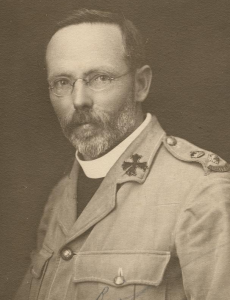Garland was born on 4 October 1864 in Dublin, son of James Garland, librarian, and his wife Mary, née Saunders. In 1886 Garland migrated to New South Wales, via a short stay in Toowoomba, Queensland. After what appeared as an attempt at a career in the law, in 1889 Garland the Church of England ministry, serving first in the role as a deacon he served in Grafton, Quirindi and Narrandera. He was ordained in Perth, Western Australia, in 1892. In the Western Australia diocese, Garland rose through the ranks, Diocesan Registrar and Secretary (1895-1902), Chaplain to the Bishop (1894-1902) and Canon of Perth (1900-1902). In 1902 Garland moved to Queensland, to become the Rector of Charters Towers, and a Canon of St James Cathedral, Townsville. The following year Garland was appointed Archdeacon of North Queensland (1903-1904), later appointed Registrar (1904-1907). In 1907 he took the primary organising position in the Bible in State Schools League. Although the biblicalist campaign had mainline Protestant inter-denominational support, it was largely being pushed by the Queensland Anglican Church. It was somewhat incongruent with the Queensland tradition being mainly Anglo-Catholic, however, there lay in the institution’s view of cultural sanctification an evangelicalistic vision of Anglo culture immersed in the philosophic outlook of the sacred book tradition. The arguments for biblicalist campaigns, from the Anglican stance, had the logic of informally establishing the Church as the moral guardian for the state, while denying there was any formal establishment of Church carried out in the Australasian colonies. Garland was successful in introducing religious instruction in state schools during school hours (provisions had previously existed for out-of-school hour’s religious instruction) with a majority vote on the issue in the 1910 referendum.
Garland’s prominence did not arise until the events of the Great War. Garland was the Founder and Director of Soldiers Help Society, the co-founder of the Compulsory Service League, the Organising Secretary for the Queensland Recruitment Committee, and served as a chaplain in Egypt and Palestine. Garland was also the Secretary of the Queensland Anzac Day Commemoration Committee. John Moses and George Davis (2013) argued the case for Garland as the originator of the transnational ANZAC Day tradition. A less known factor about Garland’s military service was his peace-making efforts in the Middle East during and after the conflict. He was one of the first chaplains to arrive into the holy city of Jerusalem after it fell into the control of Allies forces. Garland was awarded the knighthood of the Gold Cross of the Holy Sepulchre by the patriarch of Jerusalem, after providing liaison between the British military authorities and the Coptic Church during the 1919 Egyptian rebellion.
As the Rector of the Ithaca Parish, Brisbane, from 1920, Garland continued to have a high public profile in Queensland. He became the President of the New Settlers' League from 1926. The following year (1927) Garland organised radio broadcasts of his Sunday services at St. Barnabas Anglican Church in the parish. Garland also organised other important broadcasts, such as a communion breakfast with the principal speaker being the Queensland Labor Premier, William Forgan Smith. That particular episode in 1937 was an attempt on Garland’s part to bypass the Australian Broadcasting Commission ban on politicians from broadcasting for three months before the Federal election. It is said that the controversy within the national broadcaster over the incident, led to the formation of the non-government radio station company, 4BC.
See David John Garland on Scatterplot Matrix.
References
Moses, John. George F. Davis. Anzac Day Origins: Canon DJ Garland and Trans-Tasman Commemoration. Barton, A.C.T. Barton Books, 2013.
Mansfield, Wendy M. 'Garland, David John (1864–1939)', Australian Dictionary of Biography, National Centre of Biography, Australian National University, http://adb.anu.edu.au/biography/garland-david-john-6278/text10821, published first in hardcopy 1981, accessed online 6 September 2015.


